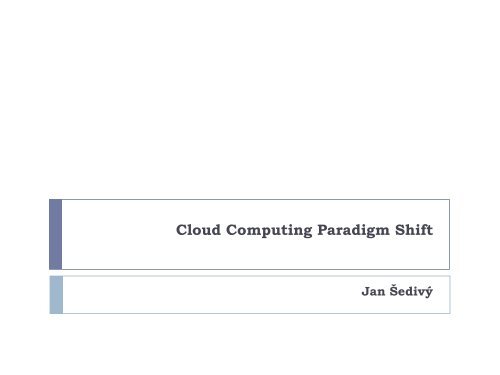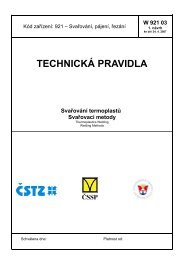Cloud Computing Paradigm Shift
Cloud Computing Paradigm Shift
Cloud Computing Paradigm Shift
You also want an ePaper? Increase the reach of your titles
YUMPU automatically turns print PDFs into web optimized ePapers that Google loves.
<strong>Cloud</strong> <strong>Computing</strong> <strong>Paradigm</strong> <strong>Shift</strong>Jan Šedivý
Business expectations Improving business processes Reducing enterprise costs Increasing the use of information/analytics Improving enterprise workforce effectiveness Attracting and retaining new customers Creating new products or services (innovation) Managing change initiatives Expanding current customer relationships Consolidating business operations Targeting customers and markets more effectively
<strong>Computing</strong> Evolution
Gartner predicts:• Virtualization• <strong>Cloud</strong> computing• Web 2.0IDC, Gartner$16B – revenue drive by public cloud in 2009$55B – revenue anticipated by 201412% public cloud share in IT spending25% - new growth in IT spendingAggressive prediction$63B - 2010 revenue, public cloud$148B – 2014 in SaaS, PaaS, IaaS
Agenda - <strong>Cloud</strong> computing Cost - Economy of scale Centralized management Easy on users Access any time any place, compatible browser Deployment model Elasticity, endless processing power, endless memory High service availability Security Types of applications
Economy of scale• <strong>Cloud</strong> data centers with large number ofcomputers• Built from computers with minimum number of parts.• Bought in massive quantities.• Efficient ratio of staff to machines.• Electricity cost is decreased 5-7 times in a large center(5MW)• Cost advantage, no upfront payment, pay as you go,Freemium• Global companies => large data centers• SMBs, SaaS, CAPEX => OPEX
Central administration• <strong>Cloud</strong> central administration - fastdistribution of new functionalityand upgrades• Employees easier adapt to smallimprovements than to disruptivechanges.• Traditional software - long learningcycle
Connect Anywhere, Anytime<strong>Cloud</strong>, Web-based applications give users full access totheir information anywhere, anytime,• Windows, OS X, Linux• FireFox, IE, Chrome, Safari ...• Mobile phone, tablet computerThe data is stored in the cloud – not on employeescomputers, sharingMultiple users can access and contribute to projectssimultaneouslyEmployees need only notebook + connectivity.The name cloud computing wasinspired by the cloud symbol that'soften used to represent the Internet inflow charts and diagrams.
Deployment models Public cloud – internet Private cloud – intranet Hybrid cloud – internet + intranet Community cloud – intranetIntranetInternetPrivate datacenterCommunityData center
Public - private centerAdvantage Public cloud Private cloudAppearance of infinitecomputing resourcesElimination of up frontpayment by cloud useryesyesPay as you use yes nononoEconomies of scale due tovery large centerHigher utilization bymultiplexing resourcesyesyesUsually notDepends on size
Higher Reliability and Uptime• Service Level Agreement (SLA)• Disaster recovery plan• Recovery point objective (RPO) design target is zero• Recovery time objective (RTO) design target is instant fail over• Databases NoSQL Data replication- build in redundancy• Elasticity, virtualization, endlesscomputing power• Fall back to secondary data center,regions, zones• This level of reliability with onpremisesor hosted technology istremendously costly and complex
Security• Browser-based applications do not need to savesensitive data on local devices.• Lost laptops and memory stick minimize the amount ofsensitive data stored on these devices• Regular staff training and educating in all aspectsinternet safety and security is must.• SAS 70 Type II auditoooooLogical security: reasonable assurance of providing access toauthorized individuals onlyPrivacy: reasonable assurance of data privacy, implement properpolicies and proceduresData center physical security: good protection of data centers andcorporate officesIncident management and availability: reasonable assurancedata centers and applications are redundant and incidents are properlyreported, responded to, and recordedChange management: reasonable assurance that development andchanges are properly tested
<strong>Cloud</strong> architecture - apps Client any browser, native app Software as a Service – SaaS Google, Microsoft Platform as a Service – PaaS Google app engine Microsoft Azure Infrastructure as a Service – IaaS Amazon AWS, Rack spaceBrowserSaaSPaaSIaaSservers
Utilization virtualization
Utilization Ggg
Utilization Hhhhh
Virtualization Run several applications on the same box Virtualize – use 20% of available resources Utilize the whole box 80%
Virtulization hh
WEB applications - Architecture multiple cloud components communicating with each other 3-tier architecture. Architectonical pattern MVC model API application programming interfaces, web services software architecture = RepresentationalState Transfer (REST) View, interaction –browser,native application,different platformsControllerModelView
<strong>Cloud</strong> applications Storage – backup General number crunching applications Web applications - services Autonomic computing Client–server model Grid computing Mainframe computer Utility computing Peer-to-peer Service-oriented computing
















